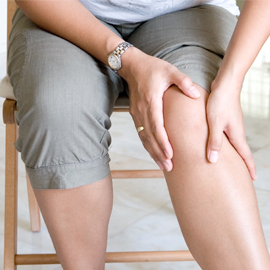Joint Ventures
 Injury notwithstanding, most of us have enjoyed smooth operation of the joints connecting the bones in our body that allow us to walk, run, bend and contort in the enormous range that our bodies are capable of. Of course, that was then, and this is now. If you’re a baby boomer not every movement is as smooth and comfortable as it once was. And with most adults having just over 230 movable or semi-movable joints in their bodies, osteoarthritic joint pain that develops with age is not easily ignored.
Injury notwithstanding, most of us have enjoyed smooth operation of the joints connecting the bones in our body that allow us to walk, run, bend and contort in the enormous range that our bodies are capable of. Of course, that was then, and this is now. If you’re a baby boomer not every movement is as smooth and comfortable as it once was. And with most adults having just over 230 movable or semi-movable joints in their bodies, osteoarthritic joint pain that develops with age is not easily ignored.
Joints are Amazing
As an engineering feat, joints are quite remarkable. Lined with a substance called cartilage, joints are nearly frictionless machines. Cartilage is said to be about 8 times more slippery than ice and it serves as both a shock absorber and a reservoir for the lubricating fluid that helps protect the joint surface during load bearing and repetitive movement. While it is perfectly designed for its job, the problem is that cartilage has no blood vessels or nerves and a very limited ability to repair itself. This means that damage through injury or aging is not usually reversible.
Joint Damage Affects Many of Us
As a result, over 27million of us suffer the irreversible effects of osteoarthritis in America today. This means that every day we wake with aching and soreness in our joints or suffer from discomfort after periods of activity or overuse. The joints that are most affected are the load bearing joints in the feet, knees, hips and back and those small joints in the hands that we use almost constantly.
Fat Makes Joint Damage Worse
It is not a surprise that if the load bearing joints are the ones that are the most likely to be affected by osteoarthritis then carrying extra weight will likely make the problem worse. More surprising though is that not just the weight but the fat itself contributes to making the symptoms of osteoarthritis worse. While most of us think of fat as no more than something to be compressed and concealed by Spanx, at a cellular level fat is doing far more than just sitting around making you look pudgy. Fat produces a host of chemicals involved in everything from appetite control to inflammation. It is inflammation that is most important to you if you have osteoarthritis. Fat produces a group of chemicals called adipokines and many of these promote inflammation some specifically targeting joints.
So not only does being overweight cause more stress and damage to joints that may already have osteoarthritis, chemicals released from fat cells actually contribute to the destruction of cartilage in joints that are not weight bearing. This is why being overweight can make osteoarthritis in your hands worse.
Keeping Your Joints Healthy
- If you want to keep a joint from degenerating the best way is to lose weight and keep the muscles surrounding the joint strong. If you don’t have extra weight and the muscles are sharing the load the stress on the joint is reduced.
- Keeping your muscles strong means working them regularly. This can be difficult if you already have discomfort from osteoarthritis. The most common exercise to work into your day is walking. It is low impact so you are not injuring joints while you do it and it is useful for the feet, knees and hips that are frequently affected by osteoarthritis.
- Other frequently employed exercises for people with osteoarthritis are water aerobics or swimming, yoga or Pilates, and cycling. Even gentle use of weights with bands or weight machines is beneficial. Of course, The last thing you want when you start an exercise program is to make your problem worse so consult with your doctor and ensure that you maintain proper body mechanics throughout the exercise to stay safe.
- Getting older does not mean we have to feel older, at least not all at once. If we don’t exercise the joints can’t stay healthy and eventually we pay for it so it is time to make a decision. You don’t have to be an athlete, just active.
- You don’t have to be in pain all the time either. There are many treatments available for osteoarthritis besides pain killers. Joint health is far more than simply taking a Tylenol. Come and talk with us about your options.
Finally, consider losing weight for the sake of your joints. This is not a simple task we know. Some people can do it on their own, but most can’t. That is a topic for another article but suffice to say, if you know you need help to lose weight, your best bet is to get help from a medical program that specializes in weight management. I accept that there may be bias in this advice.


